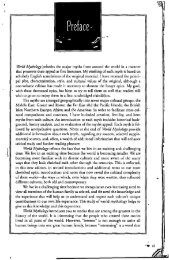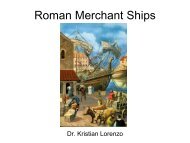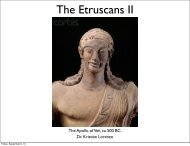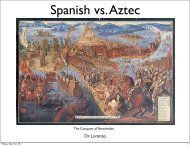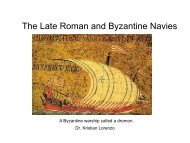9-24-2012-Warships-II-III-The Phoenicians
9-24-2012-Warships-II-III-The Phoenicians
9-24-2012-Warships-II-III-The Phoenicians
You also want an ePaper? Increase the reach of your titles
YUMPU automatically turns print PDFs into web optimized ePapers that Google loves.
<strong>Warships</strong> <strong>II</strong>: <strong>The</strong> <strong>Phoenicians</strong><br />
Phoenician<br />
coin showing a<br />
warship, a<br />
hippocampus,<br />
and a murex<br />
shell<br />
Dr. Kristian Lorenzo
<strong>Warships</strong> I<br />
<strong>Warships</strong> <strong>II</strong>: Topics<br />
<strong>The</strong> Bronze Age<br />
Shell or Hull-First technique<br />
Mortise-and-Tenon Construction<br />
Pabuç Burnu Archaic shipwreck<br />
<strong>Warships</strong> <strong>II</strong><br />
<strong>Warships</strong> <strong>II</strong>I:<br />
Laced Construction and Homer’s Odyssey<br />
Who were the <strong>Phoenicians</strong>?<br />
Phoenician Biremes<br />
<strong>The</strong> Greeks
<strong>Warships</strong> I: Bronze Age<br />
Mycenaean Warship from Kynos with a single bank of rowers, ca. 1200 BC
<strong>Warships</strong> I: Bronze Age<br />
Mycenaean Warship<br />
from Kynos with a<br />
single bank of rowers,<br />
ca. 1200 BC<br />
A – starboard or right-hand gunwale*<br />
X – port or left-hand gunwale<br />
B – rower’s gallery<br />
C – keel<br />
*the upper edge or planking of the side<br />
of a boat or ship
<strong>Warships</strong> I: Bronze Age<br />
Castles*<br />
Mycenaean Warship from Kynos with a single bank of rowers, ca. 1200 BC<br />
*castle – an often raised part of the main deck from which archers and other<br />
fighting men could shoot arrows
<strong>Warships</strong> I-<strong>II</strong>: Shell or Hull-First technique<br />
Uluburun Ship ca. 13 th<br />
century B.C.<br />
Reconstruction of the shell or hullfirst<br />
Kyrenia shipwreck (ca. 300<br />
BC)
<strong>Warships</strong> I-<strong>II</strong>: Shell or Hull-First technique<br />
<strong>The</strong> hull or skin is built of planks<br />
<strong>The</strong> keel or spine supports the<br />
length of your ship
<strong>Warships</strong> I-<strong>II</strong>: Shell-First Technique<br />
Wood Planks<br />
Oak Pegs<br />
Mortise holes<br />
Tenons<br />
Mortise-and-Tenon Construction
Mortise-and-Tenon Construction<br />
Schematic of Uluburun Mortise-and-Tenon<br />
Construction<br />
Remains of Uluburun Hull in situ
<strong>Warships</strong> I-<strong>II</strong>: Shell-First technique<br />
Labour intensive<br />
Idiosyncratic<br />
More intuitive than actually engineered.<br />
But there is another way….
Pabuç Burnu: the earliest shipwreck with hull remains<br />
in the Aegean (ca. 530 B.C.)<br />
Excavation of the Archaic Period Pabuç Burnu shipwreck, sunk ca. 530 B.C. near<br />
Halicarnassus, Aegean Coast of Turkey
Pabuç Burnu: the earliest shipwreck with hull remains<br />
in the Aegean (ca. 530 B.C.)<br />
Excavated Amphorae and Hull<br />
fragments of the Archaic Period Pabuç<br />
Burnu shipwreck, near Halicarnassus,<br />
Aegean Coast of Turkey
Pabuç Burnu: the earliest shipwreck with hull remains<br />
in the Aegean (ca. 530 BCE)<br />
Photographic<br />
recording of<br />
preserved<br />
remains of the<br />
hull of the Pabuç<br />
Burnu ship
Pabuç Burnu Shipwreck and Homer’s Odyssey Bk 5.<strong>24</strong>4-57<br />
Odysseus fleeing the clutches of Calypso: ‘He bored all the pieces and fit them one to<br />
another, and then with pegs and lacings he joined it together.’
<strong>Warships</strong> <strong>II</strong>
<strong>Warships</strong> <strong>II</strong>: Who were the <strong>Phoenicians</strong>?<br />
A Semitic or Asiatic people<br />
originating along the coast of<br />
modern Syria and Israel.
<strong>Warships</strong> <strong>II</strong>: Who were the Assyrians?<br />
<strong>The</strong> Assyrians were a militaristic Semitic or Asiatic people originating in northern<br />
modern Iraq. An Assyrian king Tiglath Pileser I (1114-1076 B.C.) invades<br />
Phoenicia and demands tribute from the Phoenician kingdoms.
<strong>Warships</strong> <strong>II</strong>: Who were the <strong>Phoenicians</strong>?<br />
From the ancient sources they were Pan-Mediterranean:<br />
Traders<br />
Merchants<br />
Great Mariners/Seafarers<br />
Colonizers<br />
As well as Greedy and Deceitful
<strong>Warships</strong> <strong>II</strong>: <strong>The</strong> Trading Empire of the<br />
<strong>Phoenicians</strong><br />
Brown = Phoenician homeland, Areas of Colonization<br />
and Trade
<strong>Warships</strong> <strong>II</strong>: Who were the <strong>Phoenicians</strong> ?<br />
<strong>Phoenicians</strong> in a<br />
tribute scene from the<br />
palace of the Assyrian<br />
King Ashurnasirpal <strong>II</strong><br />
(ca. 859-839 B.C.).
<strong>Warships</strong> <strong>II</strong>: <strong>The</strong> Phoenician Bireme<br />
Drawing of an Assyrian<br />
relief (now lost) from<br />
the palace of Sargon <strong>II</strong><br />
(ca. 722-705 B.C.)<br />
showing Phoenician<br />
warships with 2 levels<br />
of oarsmen, a bireme.
<strong>Warships</strong> <strong>II</strong>: <strong>The</strong> Phoenician Bireme<br />
A more detailed view of a Phoenician warship from a relief in the Assyrian palace of<br />
Sennacherib (ca. 705-682 B.C.) with 2 levels of oarsmen, a bireme.
<strong>Warships</strong> <strong>II</strong>: <strong>The</strong> <strong>Phoenicians</strong><br />
<strong>Phoenicians</strong> develop and deploy a bireme = a warship with 2 levels of oarsmen<br />
A technological leap forward from Mycenaean warships with only 1 level of oarsmen<br />
Mycenaean, 12 th century B.C.<br />
Phoenician, 8-7 th century B.C.
<strong>Warships</strong> <strong>II</strong>: <strong>The</strong> Marsala Shipwrecks<br />
Two <strong>Phoenicians</strong> warships were found and excavated off the<br />
northwest coast of Sicily. However, they were not biremes,<br />
but smaller warships with 1 level of oars.
<strong>Warships</strong> <strong>II</strong>: <strong>The</strong> <strong>Phoenicians</strong><br />
An artist’s reconstruction of a small Phoenician warship, based<br />
on data derived from the excavation of the Marsala wrecks.
<strong>Warships</strong> <strong>II</strong>: <strong>The</strong> <strong>Phoenicians</strong><br />
An artist’s reconstruction of a small Phoenician warship’s rowing<br />
system, based on data derived from the excavation of the<br />
Marsala wrecks.
<strong>Warships</strong> <strong>II</strong>: Phoenician Triremes<br />
Phoenician triremes served in the Persian fleet at the Battle of Salamis, 480 B.C.
<strong>Warships</strong> <strong>II</strong>I: <strong>The</strong> Greeks<br />
Greek pottery showing<br />
warships with 2 levels of<br />
oars, ca. 800-700 B.C.
<strong>Warships</strong> <strong>II</strong>I: <strong>The</strong> Greek Trireme<br />
<strong>The</strong> Olympias: a 20 th century replica of a 5 th century B.C. trireme
<strong>Warships</strong> <strong>II</strong>-<strong>II</strong>I: <strong>The</strong> <strong>Phoenicians</strong>: What’s so<br />
important?<br />
Phoenician biremes are a continuation of the technological<br />
evolution which began with Bronze Age monoremes.<br />
This 2 nd stage of tech evolution is an important precursor step<br />
towards the development of the trireme<br />
A stronger, more powerful, faster fighting ship able with the<br />
addition of a ram to be a weapon in and of itself
<strong>Warships</strong> <strong>II</strong>-<strong>II</strong>I: <strong>The</strong> Ram<br />
the ‘evolution’ of the warship from a troop transport and<br />
fighting platform to a weapon





